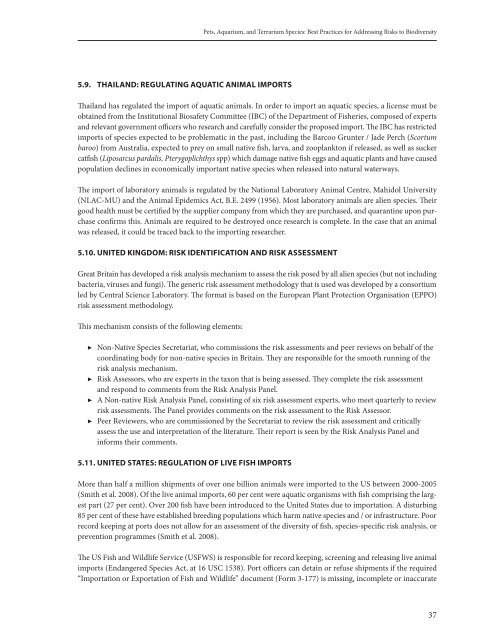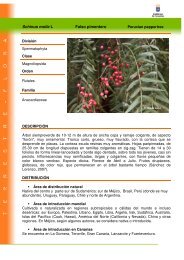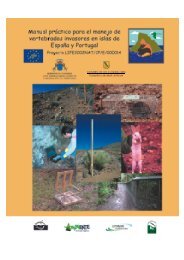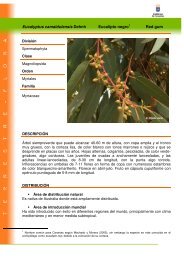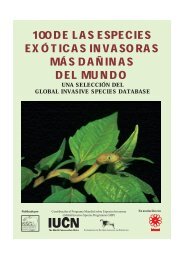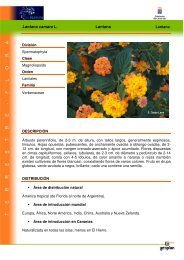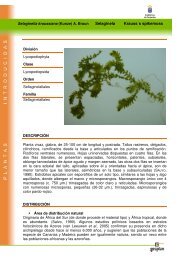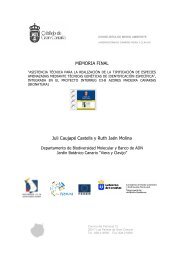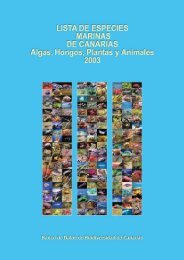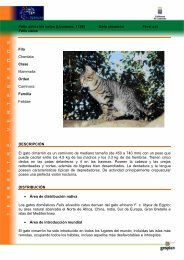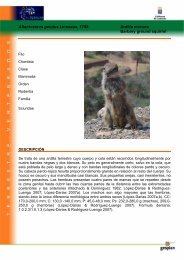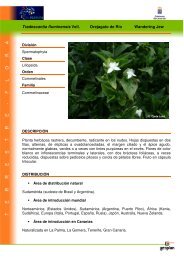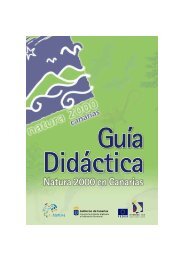Pets, Aquarium, and Terrarium Species - Convention on Biological ...
Pets, Aquarium, and Terrarium Species - Convention on Biological ...
Pets, Aquarium, and Terrarium Species - Convention on Biological ...
Create successful ePaper yourself
Turn your PDF publications into a flip-book with our unique Google optimized e-Paper software.
<str<strong>on</strong>g>Pets</str<strong>on</strong>g>, <str<strong>on</strong>g>Aquarium</str<strong>on</strong>g>, <str<strong>on</strong>g>and</str<strong>on</strong>g> <str<strong>on</strong>g>Terrarium</str<strong>on</strong>g> <str<strong>on</strong>g>Species</str<strong>on</strong>g>: Best Practices for Addressing Risks to Biodiversity<br />
5.9. Thail<str<strong>on</strong>g>and</str<strong>on</strong>g>: Regulating Aquatic Animal Imports<br />
Thail<str<strong>on</strong>g>and</str<strong>on</strong>g> has regulated the import of aquatic animals. In order to import an aquatic species, a license must be<br />
obtained from the Instituti<strong>on</strong>al Biosafety Committee (IBC) of the Department of Fisheries, composed of experts<br />
<str<strong>on</strong>g>and</str<strong>on</strong>g> relevant government officers who research <str<strong>on</strong>g>and</str<strong>on</strong>g> carefully c<strong>on</strong>sider the proposed import. The IBC has restricted<br />
imports of species expected to be problematic in the past, including the Barcoo Grunter / Jade Perch (Scortum<br />
baroo) from Australia, expected to prey <strong>on</strong> small native fish, larva, <str<strong>on</strong>g>and</str<strong>on</strong>g> zooplankt<strong>on</strong> if released, as well as sucker<br />
catfish (Liposarcus pardalis, Pterygoplichthys spp) which damage native fish eggs <str<strong>on</strong>g>and</str<strong>on</strong>g> aquatic plants <str<strong>on</strong>g>and</str<strong>on</strong>g> have caused<br />
populati<strong>on</strong> declines in ec<strong>on</strong>omically important native species when released into natural waterways.<br />
The import of laboratory animals is regulated by the Nati<strong>on</strong>al Laboratory Animal Centre, Mahidol University<br />
(NLAC-MU) <str<strong>on</strong>g>and</str<strong>on</strong>g> the Animal Epidemics Act, B.E. 2499 (1956). Most laboratory animals are alien species. Their<br />
good health must be certified by the supplier company from which they are purchased, <str<strong>on</strong>g>and</str<strong>on</strong>g> quarantine up<strong>on</strong> purchase<br />
c<strong>on</strong>firms this. Animals are required to be destroyed <strong>on</strong>ce research is complete. In the case that an animal<br />
was released, it could be traced back to the importing researcher.<br />
5.10. United Kingdom: Risk Identificati<strong>on</strong> <str<strong>on</strong>g>and</str<strong>on</strong>g> Risk Assessment<br />
Great Britain has developed a risk analysis mechanism to assess the risk posed by all alien species (but not including<br />
bacteria, viruses <str<strong>on</strong>g>and</str<strong>on</strong>g> fungi). The generic risk assessment methodology that is used was developed by a c<strong>on</strong>sortium<br />
led by Central Science Laboratory. The format is based <strong>on</strong> the European Plant Protecti<strong>on</strong> Organisati<strong>on</strong> (EPPO)<br />
risk assessment methodology.<br />
This mechanism c<strong>on</strong>sists of the following elements:<br />
▶▶<br />
N<strong>on</strong>-Native <str<strong>on</strong>g>Species</str<strong>on</strong>g> Secretariat, who commissi<strong>on</strong>s the risk assessments <str<strong>on</strong>g>and</str<strong>on</strong>g> peer reviews <strong>on</strong> behalf of the<br />
coordinating body for n<strong>on</strong>-native species in Britain. They are resp<strong>on</strong>sible for the smooth running of the<br />
risk analysis mechanism.<br />
▶▶<br />
Risk Assessors, who are experts in the tax<strong>on</strong> that is being assessed. They complete the risk assessment<br />
<str<strong>on</strong>g>and</str<strong>on</strong>g> resp<strong>on</strong>d to comments from the Risk Analysis Panel.<br />
▶▶<br />
A N<strong>on</strong>-native Risk Analysis Panel, c<strong>on</strong>sisting of six risk assessment experts, who meet quarterly to review<br />
risk assessments. The Panel provides comments <strong>on</strong> the risk assessment to the Risk Assessor.<br />
▶▶<br />
Peer Reviewers, who are commissi<strong>on</strong>ed by the Secretariat to review the risk assessment <str<strong>on</strong>g>and</str<strong>on</strong>g> critically<br />
assess the use <str<strong>on</strong>g>and</str<strong>on</strong>g> interpretati<strong>on</strong> of the literature. Their report is seen by the Risk Analysis Panel <str<strong>on</strong>g>and</str<strong>on</strong>g><br />
informs their comments.<br />
5.11. United States: Regulati<strong>on</strong> of Live Fish Imports<br />
More than half a milli<strong>on</strong> shipments of over <strong>on</strong>e billi<strong>on</strong> animals were imported to the US between 2000-2005<br />
(Smith et al. 2008). Of the live animal imports, 60 per cent were aquatic organisms with fish comprising the largest<br />
part (27 per cent). Over 200 fish have been introduced to the United States due to importati<strong>on</strong>. A disturbing<br />
85 per cent of these have established breeding populati<strong>on</strong>s which harm native species <str<strong>on</strong>g>and</str<strong>on</strong>g> / or infrastructure. Poor<br />
record keeping at ports does not allow for an assessment of the diversity of fish, species-specific risk analysis, or<br />
preventi<strong>on</strong> programmes (Smith et al. 2008).<br />
The US Fish <str<strong>on</strong>g>and</str<strong>on</strong>g> Wildlife Service (USFWS) is resp<strong>on</strong>sible for record keeping, screening <str<strong>on</strong>g>and</str<strong>on</strong>g> releasing live animal<br />
imports (Endangered <str<strong>on</strong>g>Species</str<strong>on</strong>g> Act, at 16 USC 1538). Port officers can detain or refuse shipments if the required<br />
“Importati<strong>on</strong> or Exportati<strong>on</strong> of Fish <str<strong>on</strong>g>and</str<strong>on</strong>g> Wildlife” document (Form 3-177) is missing, incomplete or inaccurate<br />
37


